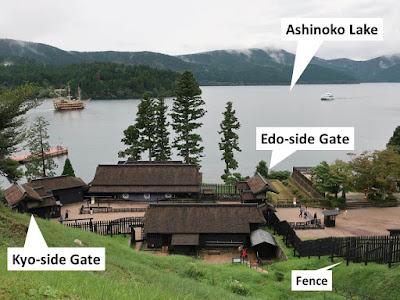Hakone Sekisho check point 箱根関所
There were 53 check points on the kaidou
high-way in the Edo period to check passports of domestic travelers. The
check point is called “sekisho”. “Hakone Sekisho” was rebuilt in 2004 based on excavation
records and historical materials; it is in a mountainous area near Hakone pass.
If you approach to Hakone Sekisho from Edo (old name of Tokyo), you walk down
to the Ashinoko Lake and you find Hakone Sekisho beside the lake. The fence of
the check point is installed even in the mountain. There is a lookout where
officials checked ships that go across the lake.
江戸側から行くと、芦ノ湖に下った湖のそばに関所がある。関所の門から、山に向けて柵が伸びている。柵に沿って山側に登っていくと、見張り場所・遠見番所がある。船で関所を回避するものを監視したという。
 |
| 旧東海道から箱根の関所を望む |
 |
| View of Hakone check point from the Lookout、遠見番所からみた関所全景 |
 |
Edo-side Gate of the check point; the left side is a waiting space called "Sen-nin Damari" in which "Sen-nin" is for one thousand people and "Damari" means a waiting space.
江戸側の門、江戸口御門。左が江戸口千人溜りで通関の順番待ちスペース。
Hakone Sekisho was built before the Edo
period. Tokugawa shogunate controlled it from 1619 to check the traffic
of Toukaidou which links Edo and Kyoto.
The Hakone Sekisho checked women thoroughly,
because female family members of daimyous were forced to stay in Edo as
hostages and Tokugawa shogunate prevented them from escaping. Physical feature
was written on a passport, for example the place of moles and bald spots which
is exhibited in the Exhibition Hall. Female checkers inspected travelers. Old
local women took a role of checkers, so they were called “Aratame-babaa”,
“aratame” means to check and “babaa” means old women.
 |
| Doll of a checker and a traveler、人見女の改めの様子 |
箱根の関は中世からあったが、江戸幕府が関所を置いたのは1619年、以来、明治2年(1869年)に廃止されるまで、250年間、東海道の通行を管理した。特に、女性の管理は厳しかった。女性は幕府の御留守居役が発行する女通行手形を持っていることが通過の条件になる。手形には、体の特徴が記載されていた。資料館に展示されていた手形には、腫物の痕や髪の中のハゲの位置が書かれていた。役人である人見女が本人に相違ないかを確認する。人見女は、地元の年配の女性が務め、改婆(あらためばばあ)と呼ばれていたらしい。人質として江戸に置いている大名の家族が逃亡しないか管理したという。
On the other hand, men were not
checked so carefully. The rule of Hakone Sekisho was written on the bulletin board
near the gate.
It mentions that,
- People
have to take off hats or hoods.
- People
on a palanquin have to open the window.
- Women
have to be identified by passports
-
Injured, dead and other suspicious people never pass through here without passports
- Nobles and daimyous who informed beforehand are not checked.
Women, Injured, dead and other
suspicious people were checked carefully here.
一方、男性に対しては緩かったし、入鉄砲は管理範囲外だった、ということを初めて知った。関所の通行要件は高札に記載。
一、関所を出入る輩、笠・頭巾をとらせて通すべきこと
一、乗物にて出入る輩、戸を開かせて通すべきこと
一、関より外に出る女は、つぶさに証文に引き合わせて通すべきこと
附、女乗物にて出る女は、番所の女を差し出して、相改むべきこと
一、手負・死人並びに不審なるもの、証文なくして通すべからざること
一、堂上の人々・諸大名の往来、かねてよりその聞こえあるは沙汰に及ばず、
若し不審のことあるにおいては、誰人によらず改むべきこと
チェックしたのは、女、けが人、死人、不審な者ということになる。
There are Oobansho in
which travelers were checked and Ashigaru-bansho which was a lower class officials' house for
break-off. There are also hitching-posts for horses.
 |
| Oobahsho office and hitching posts、大番所と馬繋ぎ柱 |
Inside the Oobansho office, there are dolls of
officials who checked travelers. In a special office, guns and Japanese
archery intimidated travelers. This office was also used to host daimyous and
high class samurais. I am attracted in an arrow case called "Do-hyou" which is set
beside the superior officer and is decorated with bear bristles. It is beautiful
and dignified.
 |
| Oobansho office、面番所 |
 |
| Special office in Oobansyo、上の間 |
 |
| Dohyou arrow case、弩瓢 |
道の左右に取り調べを行う大番所と下級役人の休憩所である足軽番所があり、馬をつなぐ外繋もある。大番所の中には、役人の人形と武器が置かれている。上級役人の横には弩瓢(どひょう)という矢を入れる入れ物が置かれているのは、矢を入れるうつぼに熊のものと言われている毛をつけている。立派だが何だろうか、と思ってしまう。
Behind
the office, there is a café space. In Ashigaru-bansho which is a house for low
class officials to stay and break, everyone looks so relax.
 |
| Café space in Oobansho、勝手板の間 |
 |
| Ashigaru-bansho house、足軽番所 |
大番所の裏手バックヤード、勝手板の間の役人たち。ほっと一息スペースだ。足軽番所(休息所)、更にリラックスできる場所だ。
Hakone Sekisho Exhibition Hall 箱根関所資料館
Photography is
prohibited.
The history is presented, old weapons and
travel goods are exhibited. The model of the daimyo procession is shown
too. Hakone Sekisho was managed by Odawara han which dispatched 20 to 24
officials to the check point and they worked in shift for one month. Six illegal
transits and nineteen illegal attempts were reported. It was dishonorable
for Odawara han, so probably the recorded number wasn't a real one. The
officials confronted a soldiery only once at the end of the Edo period, but
they didn’t fight and the soldiery passed the check point.
In 1729, an elephant landed on
Nagasaki, it stayed in Hakone post town beside the Ashinoko Lake from 14th to 19th of May because of bad health condition. Guard officials were so worried
because Tokugawa shougun was going to meet the elephant. The elephant walked around 1200km to Edo. It
is said that the shougun planed the event in order to encourage people by showing the rare animal at that time.
Travel goods are also exhibited. My preferred item
is a tool set which has seven tools including small scissors and tweezers.
Travel is fun itself however these cute items add much fun to the travel.
撮影禁止。
関所の歴史、武器、旅の道具などが展示品とともに紹介されている。大名行列の模型もあった。
箱根関所は、小田原藩が管理し、一月交代で20~24人の役人が駐在した。記録された関所破りは6件で、未遂事件である藪入りは19件。ただし、小田原藩の威信にかかわるので少な目の数字と書かれていたらしい。幕末には、遊撃隊と対峙することもあったが、戦とはならず通過させている。1729年、長崎に陸揚げられた象も関所を越えた。ただ、体調を崩し5/14から6日間、箱根に滞在したそうだが、吉宗との拝謁があるため死んでしまったら大事で、侍たちもひやひやしたようだ。絵が展示されていた。1200kmも歩いた象も大したものた。吉宗が国民に象を見せて元気づけようとしたイベントだったという。
展示品の中では、旅の道具として、小さなはさみやとげぬきなどを纏めた七つ道具という可愛らしい旅行用品があった。旅は楽しいが、この小物自体も楽しい。
Official website
Hakone
check point: http://www.hakonesekisyo.jp/english/index.html
(English)
Hakone
Sekisho Exhibition Hall : http://www.hakonesekisyo.jp/db/data_inc/inc_frame/fr_data_02_18.html
(Japanese)
Previous post (Museum in the next post town
on Toukaidou high-way) :
Next post (Museum in the big castle city on
Toukaidou high-way) :



Comments
Post a Comment